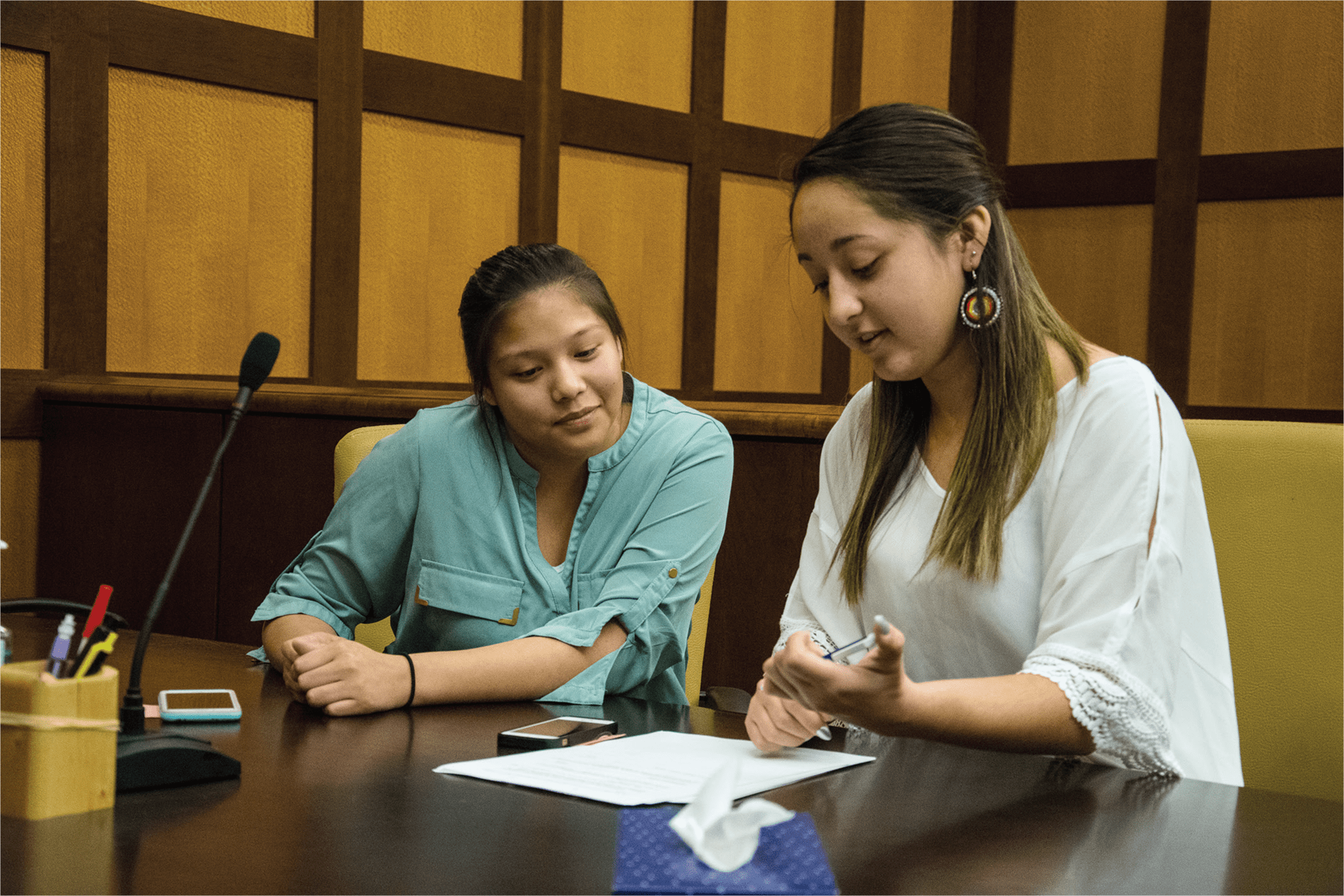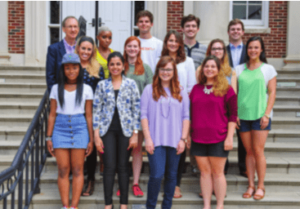Featured
Teenagers Serve as Prosecutor, Defense Counsel and Jury in Teen Court

If you’re a teenager, here is what a jury of your peers looks like in Teen Court.
From left, Audrey Tubby, Cecilia Ketcher, and Searra Wilson.
The Mississippi Band of Choctaw Indians has a novel way to deal with some teen crimes. They let the kids decide.
In teen court, teenagers serve as prosecutor, defense lawyer and jury. The only adult in the room is the judge, whose primary job is ensuring the jury doesn’t hand out inappropriate punishments, such as making kids walk around for a day wearing a sandwich board that exclaims, “I’M A THIEF.”
The teen court is mostly made up of high school girls. Andrew Jones, the court’s director, says he gets about one male for every 25 females.
Everyone, aside from the defendant, is a volunteer. “My mom made me,” is the most common reason for starting, but after that, Jones says he can’t get rid of them.
Natalie Dreifuss is in her second year with teen court. She says she likes the feeling of being a part of the justice system and of helping other kids and the tribe. It gives her a sense of responsibility. Which is exactly what the tribe wants.
The court experiment began with a federal grant in 2003. A branch of the more traditional youth court, it’s an informal sanctioning court. To be eligible, teen defendants have to admit their guilt in a formal hearing, but even that doesn’t guarantee referral to teen court. Jones meets with other court o cials to select first offenders who might be helped by the teen court process. The court has had anywhere from up to 40 cases a year to as few as two.
Just like adult court, defense lawyers meet with defendants, map out a strategy and prepare for trial. Since the defendant has already conceded guilt, the young lawyers must present mitigating evidence and seek a lesser punishment. Prosecutors plan their case against the defendant, present evidence and argue for what they consider proper punishment.
Jones assigns the roles each teen must play. First-year students typically work for the prosecution and the more experienced kids work with the defense. His advice to defense lawyers is to think of the court as an opportunity to help a client, not punish them.
“If you understand what they did was wrong, how could you help them and the community? Think about how you can educate them and help them see things differently,” Jones said.
Sometimes teen court sparks an interest in law as a profession. Tia Grisham, 25, started out with teen court, went on to attend Mississippi College and now works for the Choctaw Attorney General’s office. She liked teen court so much that she still helps Jones out.
“Defense is a lot harder,” she said. “You have to stand in their shoes and understand them and help them better themselves, but since they’ve already admitted their guilt, there’s only so much you can do for them.”
Emily Shoemake, 20, preferred defense. “You can look at them and think about what you would want if you were found guilty. You have to make sure the jury sees that we’re all human,” she said.
As a juror, she said, “You just want to know the facts, you want to know everything. It was harder to know what the facts are versus what was just being said or what they wanted us to know.”
When asked if anything had ever gone awry during a hearing, the room of teenage girls Jones had gathered for an interview fell silent. They are, after all, mostly teenagers.
When asked if feelings get hurt when a verdict doesn’t go one’s way, Grisham reasoned, “It’s hard to take it personally when you know the defendant is already guilty. They wouldn’t be here otherwise. If you were asking for one month probation, and someone gets two, then they probably deserve it, so there’s not much you can do.”
Jones says this court of teen peers offers a different perspective from the more formal youth court and can be even tougher on kids than traditional court hearings. “They know these kids, they go to school with them, so when the teen court trial comes, they’ve already heard the story. It’s nothing new to them. So they have to be unbiased and try and do what’s right, and that’s hard. But since they know the situation, they’re typically a little rougher than formal court,” he said.

Genesis Ferris, 17, and Natalie Dreyfuss, 16, demonstrated what goes on at the defense table.
No matter the verdict, defendants are later required to serve as a juror on three separate cases as a part of the court’s mission to turn kids around and instill responsibility.
Jones says there are two kinds of jurors. There are kids who say, “I don’t want to be as tough, because it was tough on me.” But then some say, “They were tough on me, so I’m going to be tough on them.”
“And what’s interesting is that those are the kids that will come back and help with the court. The kids that let them o easy are gone after three appearances.”
In the tribe’s own words, the teen court’s ultimate concern is dealing with antisocial, delinquent and criminal behavior at an early stage. It focuses on self-esteem, self-improvement and nurturing healthy attitudes toward rules and authority.
The court was a response to rising youth crime that was beginning to tax the Choctaw court system. Teen court reduces the caseload for other courts, while detouring first-time offenders from formal youth court and avoiding a youth court file.
Court administrator Dan Mittan and others in the Choctaw Justice Complex have seen tremendous change in the past 20 years. From a few cramped trailers in the old days to today’s two-story concrete, marble and glass structure, the building itself is a nod to their progress.
As teen crime rates rose, Mittan didn’t see detention as an answer. Detention facilities were overcrowded, re-arrest rates were high and he felt they were wasting money on programs that weren’t working.
To solve the problem, he developed the Juvenile Detention Alternatives Initiative, a comprehensive reform model that utilizes “collaborative and data-driven approaches to reduce reliance on juvenile incarceration,” he said.
It leans heavily on tribal traditions. The Choctaw have long considered healing and bringing people back together as major goals of any decision involving tribal justice. After all, sending parties to a dispute back into the community with one side mad and the other side gloating is not always a good recipe for community harmony.
Mittan likes the idea so much that he’s trying to apply it in other ways. He says they’re currently working on an elder-to-student mentor program that he’s seen work in other tribes.
But is it that simple? Does a program like this really work? Is allowing them to be judged by their peers — their classmates and teammates — good for defendants?
Jones says yes. He’s had more than 200 teen court cases and only 25 defendants have committed a new offense or failed to comply with the court’s ruling.
Jones has a hand in that re-offender rate, because as the intake officer, his job is to screen people coming through. Even if youth court recommends someone for teen court, Jones can turn them down if he feels their case or personality wouldn’t go over well there.
That’s about 175 cases that didn’t end up in detention, which is the tribe’s goal. In recent years, instead of stressing detention, there’s been a focus on programs and probation to reduce overall crime and reo ender rates. Because of this and the court’s initial success, the Choctaw teen court has received national recognition from Harvard University, the U.S. government and other tribes across the country.
The teen court is so new it hasn’t had time to put together meaningful long-term data. Until the court logs more experience, the Choctaw are encouraged by the fact that they have only about 50 youth cases a year. That represents 3 percent of the kids, far below the national average of youth offenders.
Hopefully, said Mittan and Jones, that’s a solid sign that it’s working.
By Mitchell Dowden. Photos by Ariel Cobbert.

LEFT TO RIGHT: Ariel Cobbert, Mrudvi Bakshi, Taylor Bennett, Lana Ferguson, SECOND ROW: Tori Olker, Josie Slaughter, Kate Harris, Zoe McDonald, Anna McCollum,
THIRD ROW: Bill Rose, Chi Kalu, Slade Rand, Mitchell Dowden, Will Crockett. Not pictured: Tori Hosey PHOTO BY THOMAS GRANING
The Meek School faculty and students published “Unconquered and Unconquerable” online on August 19, 2016, to tell stories of the people and culture of the Chickasaw and Choctaw. The publication is the result of Bill Rose’s depth reporting class taught in the spring. Emily Bowen-Moore, Instructor of Media Design, designed the magazine.
“The reason we did this was because we discovered that many of them had no clue about the rich Indian history of Mississippi,” said Rose. “It was an eye-opening experience for the students. They found out a lot of stuff that Mississippians will be surprised about.”
Print copies are available October 2016.
For questions or comments, email us at hottytoddynews@gmail.com.





























